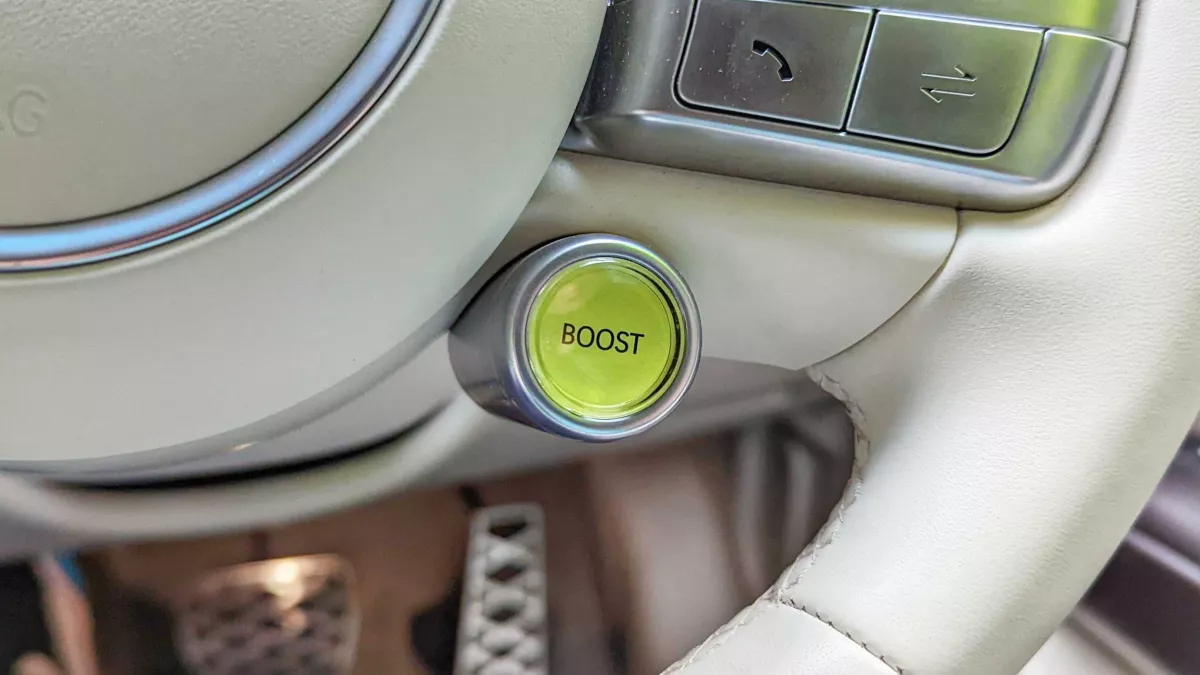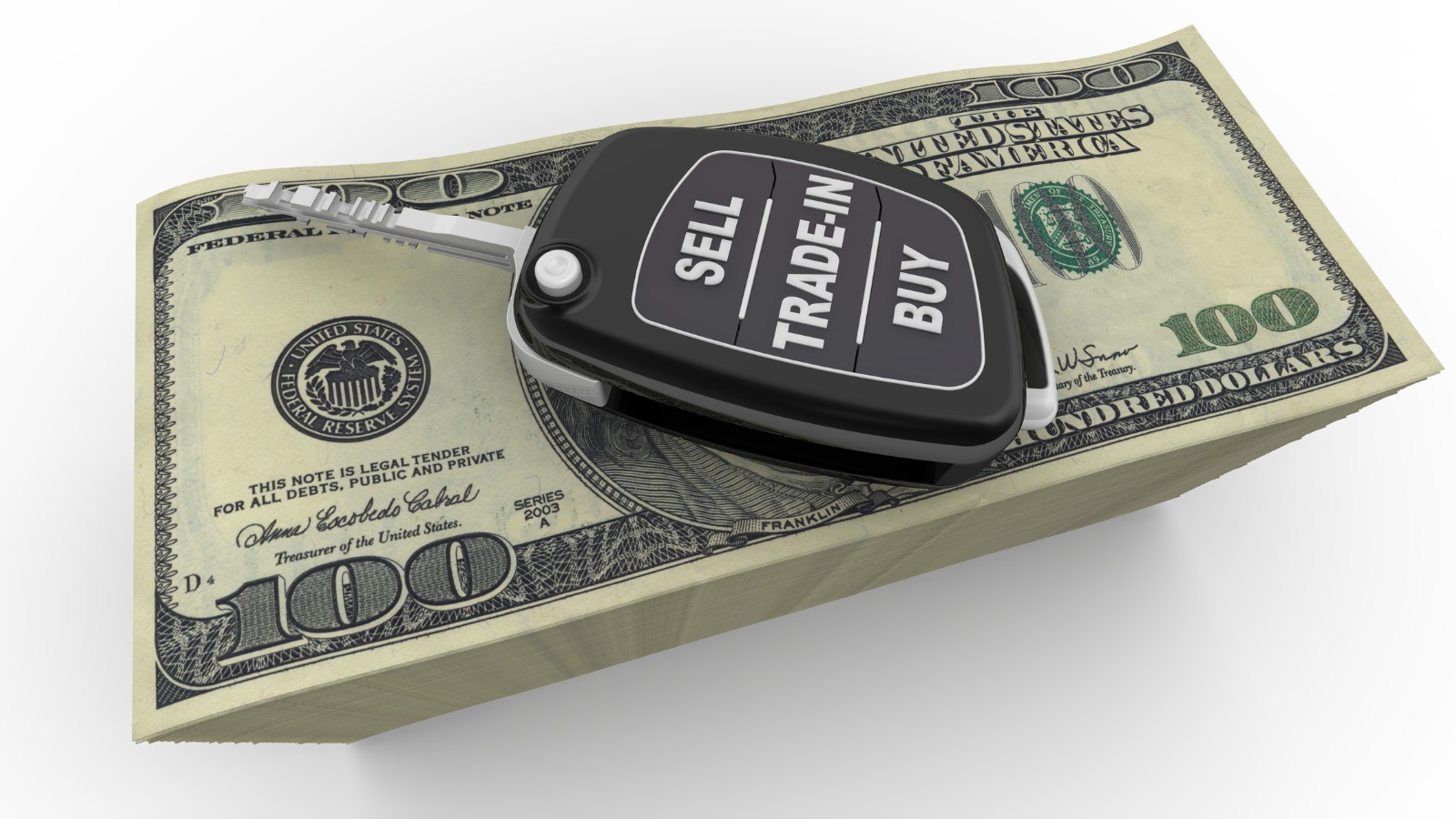Boost Button Quick Facts
- Boost adds about a 10-second power burst for passing in safe road conditions.
- Occasional use barely affects range, but using the boost button frequently hurts efficiency.
- Boost buttons are typically located on or near the steering wheel.
Electric vehicles (EVs) are already quick, but a few can go even faster with the implementation of a boost button on the steering wheel. As the name implies, the button gives the vehicle a jolt of power and speed, but it’s not unlimited. Additional power lasts only a few seconds before the car returns to normal driving mode. That means you’ll have to make the most of the few seconds you have until it is ready to do it again.
The Boost Button
Boost button variations have been around for a while. Typically, a mode used for gasoline-fueled performance cars such as the Hyundai Elantra N and the upcoming Dodge Charger Sixpack H.O., they feature steering-wheel-mounted buttons to give the engine a power punch. Now, power boost modes seem to be catching on in the electric car world.
As with gas-powered cars, engaging the boost in an EV releases a hefty increase in horsepower for a limited amount of time (10-20 seconds or so), delivering a burst of acceleration.
How Does the Boost Button Work in EVs?
Unlike the boost function in combustion-engine cars that manipulates a turbocharger to achieve the desired effect, in an EV the adrenaline hit comes from increasing the current flow from the battery. How is that possible? Well, just as some performance cars have speed limiters on their engines artificially confining their maximum speed to a number below their actual capability, EV systems generally operate at a level a bit below their performance limit. This is primarily to manage the overheating that would occur if constantly operating at maximum output. However, drawing an additional burst of current from the battery array for a few seconds doesn’t negatively impact the EV system components. In light of this, we are surprised more EVs don’t offer boost technology.
Does Engaging the Boost Function Affect an EV’s Range?
Yes, without a doubt. Just as a lead-footed driver, constantly charging off when the traffic light goes green, reduces an EV’s range, so does engaging the boost button. But, guess what? Aggressive acceleration in a combustion-engine car negatively impacts its fuel economy, too. However, addressing the question of affecting range, any significant impact on range requires overusing the boost function. In the same sense that aggressively accelerating away from one green light rather than every green light won’t greatly affect range, the occasional use of the boost button won’t noticeably impact range either.
MORE: How Much Does It Cost to Charge an Electric Car?
Which EVs Have Boost Buttons?
Currently, only a few electric vehicles have a dedicated boost button: the Genesis GV60, the Hyundai Ioniq 5 N, and the Porsche Taycan. Although the “N Grin Boost” (NGB) button, activating the boost in the Ioniq 5 N, seems right at home for this sportier version of the Ioniq 5, as does the Sport Response button engaging the boosting in most of the Taycan models with the Sport Chrono package. However, some might argue that a boost button in the luxury GV60 is out of place. We believe one can make the argument that when the topic is horsepower and its availability, the instant maximum torque available to every EV makes it a performance machine.
- Genesis GV60: With 516 lb-ft torque, engaging the boost button instantly bumps output from 429 hp to 483 hp. The additional boost gives the Genesis more power than the base long-range Tesla Model 3.
- Hyundai Ioniq 5 N: The Ioniq 5 N, with its two electric motors, generates 601 hp and 545 lb-ft of torque. Pressing the NGB button pumps up the output to 641 hp and 568 lb-ft of torque.
- Porsche Taycan: Available only on models equipped with Sport Chrono package and the Performance Battery Plus, the Sport Response button initiates added horsepower lasting from 10 to 20 seconds.
Here are specs from the manufacturers.
Genesis
| Model | Regular HP | Boosted HP |
| GV60 | 429 hp | 483 hp |
Hyundai
| Model | Regular HP | Boosted HP |
| Ioniq 5 N | 601 hp | 641 hp |
Porsche
| Model | Regular HP | Boosted HP |
| Taycan (w/ Performance Battery Plus) | 429 hp | 496 hp |
| Taycan 4 (w/ Performance Battery Plus) | 429 hp | 496 hp |
| Taycan 4S (w/ Performance Battery Plus) | 509 hp | 590 hp |
| Taycan GTS | 596 hp | 690 hp |
| Taycan Turbo | 697 hp | 871 hp |
| Taycan Turbo S | 764 hp | 938 hp |
| Taycan Turbo GT | 777 hp | 1,019 hp |
Where to Find the Boost Button

In the GV60, the boost button is on the steering wheel and conveniently within reach of the driver’s right thumb, as is the bright red NGB button in the Ioniq 5 N. By the way, the boost button in gas-powered cars is in a similar position. For Porsche EVs, the Sport Response button is located in the center of the driving-mode knob just below the right spoke of the steering wheel. We suspect that when future EVs adopt the boost button, it will most likely be located on or near the steering wheel, as well.
MORE: 5 Fastest-Charging Electric Cars
When You Should and Shouldn’t Use the Boost
Chances are that you are not a drag racer. Still, you can find legitimate uses for a shot of extra power. However, that begs the question, when should and when shouldn’t you use the boost button? Here are a few suggestions.
Should
- Straight roads: Engaging the boost should be restricted to straight roads, no matter how you might use it.
- Passing: There’s a reason Porsche gave its Sport Response button the nickname push-to-pass. First, make sure the passing lane is clear and then let her rip.
- Rural highways: For slaps and giggles, you might engage the boost simply to break the monotony of a long drive.
- Racetrack: Yes, it’s highly unlikely that you will ever find yourself on a racetrack, but some tracks do have open track days, and many car clubs sponsor track days.
Shouldn’t
- Urban streets: A busy city street is nowhere to air out your EV with the boost.
- In a curve: A sudden explosion of thrust is difficult enough for most drivers to control in a straight line. Engaging the boost in a curve can send you places you don’t want to go. Likewise, don’t engage on a road full of twisties.
- Exceed the speed limit: When you are already flirting with the maximum speed posted for the road you are on, engaging the boost can push you well over it.
- Insufficient runway: As always, pass slower traffic cautiously, especially on a two-lane road. If you are unsure if your boost will last until your passing maneuver is completed, err on the side of caution and don’t pass.
- Slippery surface: Rain, snow, and ice can all rob your tires of traction. A sudden blast of thrust on a slippery surface can be fatal.
Our Take
We like fun as much as the next car geek, but overusing or abusing an EV’s boost function can be dangerous and even a bit tough on your EV’s heat management system. However, in the appropriate circumstances, that zap of power can be a blast.
Editor’s Note: This article has been updated since its initial publication.








